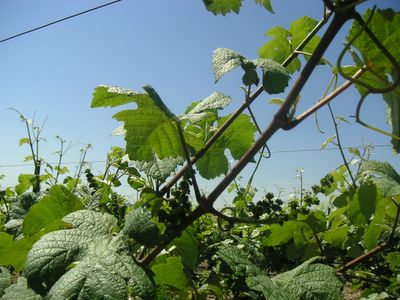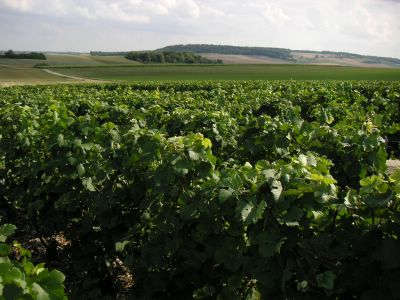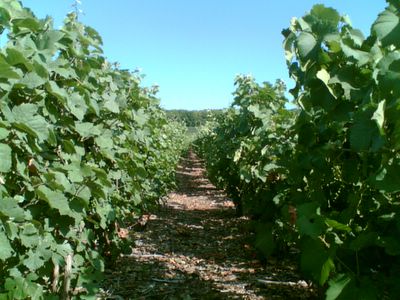 If these grapes are to follow the trend, they will be ready to harvest in the middle of September. Several weeks before the days of Alain's grandfather.
If these grapes are to follow the trend, they will be ready to harvest in the middle of September. Several weeks before the days of Alain's grandfather.Once upon a time, the winegrowers in Champagne had to cover the maturing grapes with big nets. Otherwise the fruits were eaten by birds. Today the grapes are harvested before the migrating birds show up, says my mother-in-law, who has not yet turned 75 years.
In 2004 - the year of records when it comes to the amount of grapes - we could see how the winged guests were having great eating parties with the
Chardonnay-grapes that were left on the vines, when we drove through the Côte des Blancs. Like black clouds the birds rose and hastily dived over the vines. Since then I have heard that accidents happen every year in the autumn, caused by drivers, whose eyes follow the fascinating sight, instead of the road.
Birds or not: The nets have not for years and years left the shed of the long-gone Granddad of Alain's. They tell their own story of a region that has become warmer.
More vintagesOne indicator is the amount of vintage champagnes -
millésime - that seems to be on the rise. They are only made in years, where the grapes are extra good, that is when the inner balance between sugar and acidity is phenomenal, mainly in years with a lot of sun.
Traditionally the geographical area of Champagne is on the northern limit of where it is still profitable to grow wine on a larger scale. Further north there is simply not enough hours of sun to ensure the maturation of the grapes. Or at least was not, because it seems that the pattern is changing these years.
During the 1990'ies there has been more and more vintages in Champagne. In the past vintage champagnes was the exception, now the tendency seems almost excactly the opposite. In the 1990'ies nine out of 10 years were good enough to make a vintage, in the 1980'ies six out of 10 were exceptional and in the 1970'ies the number was four out of 10. On the other side of the millenium the development so far continues: The last three years 2003, 2004 and 2005 are all
millésime.
The increased possibilities to produce vintage champagnes makes it possible to make more money per bottle as well. In other words it is a way to increase the economical growth in the region without the need of more grapes. Quite important in an area where almost all possible land within the AOC is now planted with grapes. This means that noone can easily go out and get more grapes to produce more bottles. However, it is not clear - for me anyway - if there are actually customers for more expensive champagnes.
Good grapes with an almost perfect balance between acidity and sugar is one of the positive effects of the global warming. Unfortunately other and less convenient consequences follow in the wake.
New temperatures, new customsThe big question is when the advantage will turn into the contrary. When the sun will be too much, when the grapes will mature too fast and therefore become too sweet. Which will mean more alcohol, which the producers - traditionally anyway - have not wanted. If the inner balance of the grapes will change, this will also affect the taste. The characteristic freshness of a champagne - some call it sour - originates from grapes, that has not fully ripened at the time of harvest.
A way of dealing with this could be to harvest before... or maybe change the production methods. New methods may have to be developed, just as the champagne has constantly been developed throughout the centuries... other varieties may be introduced, new ways of pruning.
Already by now there is a lot of media fuss about the new, sparkling wines from Southern England. In blind tests and world wide competitions they have beaten more or less all other sparkling wines that are not champagne. Names as Chapel Down, Ridgeview and Nyetimber are certainly interesting, and they seem to enjoy emphasizing that they are not up for sale when noble and indeed well established CEO's of real champagne houses pop by Kent and Sussex to check out the possibilities of buying shares, The Brits now want to deal with it themselves,
if you please...
The grapes move northOn top of the classic champagnes grapes -
Pinot Noir,
Meunier and
Chardonnay - vines that are today typical of the Bordelais are in the year 2100 expected to thrive better in Southern England than in the area around Bordeaux. The Rhône-valley can expect to see vines of the same type as today in Marocco and Algeria, and the Italian Chianti may grow excellently in the German valley of the Rhine. The condition is temperatures three-four degrees Celsius more than today, and the predictions are most certainly serious (printed in
Le Figaro July 29th-30th, source:
Sciences et Avenir).
According to the CIVC (Comité Interprofessionnel du vin de Champagne) the temperature in Champagne has risen 0,6 degrees Celsius during the last 50 years. Since the 1980'ies the grapeharvest has typically taken place in mid September rather than the beginning of October as in the old days of Alain's grandfather.
With other words only an increase of half a degree has been enough to speed up the grapeharvest with three weeks. It is almost imaginable what influence an increase of three-four degrees will have.
Another effect of the warmer weather is more frequent and violent storms. This July hail destroyed about 2500 hectares of vines in Champagne. I presume this is the kind of weather that will be more common. Unfortunately.
An American researcher, who has worked with the influence of the global warmning on the vineyards, Gregory Jones from the University in Oregon, last month said to La Journée Viticole, that "even there is still a lot of uncertainty around the climatic changes, this does not entitle lack of action".
Only champagne from ChampagneWhat the CIVC - key organisation of the champagne - will do regarding the global warmning, I do not know. But I presume, that all organisations that in one way or another deals with people who make their living from the land, must have a big interest in finding ways for their clients to adapt to the new challenges. In Champagne one of the big advantages is that the winegrowers can actually pay for research and development. Since they make money.
 The events in the cycle occur with a shorter distance, here flowering.Shorter intervals around the globe
The events in the cycle occur with a shorter distance, here flowering.Shorter intervals around the globeResearchers and institutions around the world have documented that the different events in the vineyards - burst, flowering, harvest - is not only taking place earlier in the season but also with shorter intervals between the events than before. Not just in France but also in places such as New Zealand and the USA.
The many and good millésimes of the last years in Champagne is also a documented effect of the global warming. An earlier date of the buds bursting as well, which may eventually be less fortunate in an area like Champagne with its constant risk of frost in spring. Just three percent of the vines are protected against frost.
The warming has also changed the frequency of different diseases. The disease
Esca - which we unfortunately know all to well here - is according to
Wine-Pages a phenomenon that sadly is spreading.
My mother-in-law, who not even knowing this has had an excellent view of global warming from the very front row, has probably never seen the different effects of warming in that way. Instead I guess that she has been quite satisfied that it is no longer necessary to protect the grapes against birds. One manual task less that is.
Eventually there will be a big intellectual and practical task to find find new methods for the vines. New vines as well, I guess.
However, no matter what grows in the vineyards of Champagne, no matter how many
Pinot Noir,
Meunier and
Chardonnay the chalky soils of Kent may contain, I am quite sure that the CIVC will still stick to their
"Il n'y a que champagne de Champagne". No matter what grapes will make the bubbles.
På danskCopyright: The copyright for text and photos at bobler.blogspot.com belongs to Solveig Tange. You may use my articles, photos or parts of them for non-commercial use and if I am credited as the author. Feel free to link to this site but not in your own frameset please.












